- Details
- Hits: 1709
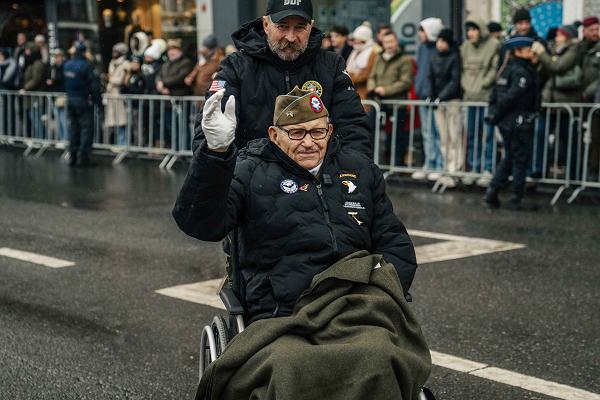
Bastogne, Belgium. (December 14, 2024): In this photo by 1st Lieutenant Dalton Worley, Soldiers assigned to the 101st Airborne Division escort World War II veterans during a parade marking the 80th anniversary of Bastogne and the Battle of the Bulge. In their nineties now, this is likely the last chance to personally honor these members of the 101st Airborne Division (Air Assault) for its defense of the city and region from the German offensive during World War II. In the Battle of the Bulge, between December 16, 1944, and January 25, 1945, the United States suffered well over 80,000 casualties, including an official Army count of 19,246 dead and more than 23,000 American troops taken prisoner.
Perhaps suffering from a sense of overconfidence, most allied troops felt the war was practically “over in 44” and many even expected to be home for Christmas. Meanwhile, Hitler had other plans. The Further was secretly massing an attack force to launch a winter offensive through a weak point in the Allied lines in the Ardennes forest. The Nazi goal was to seize Antwerp, Belgium which would drive a wedge between the British army to the north from the American army in the south. Although Hitler did not expect this attack would win the war, he believed the Americans would be more likely to negotiate peace on favorable terms.
- Details
- Hits: 1339
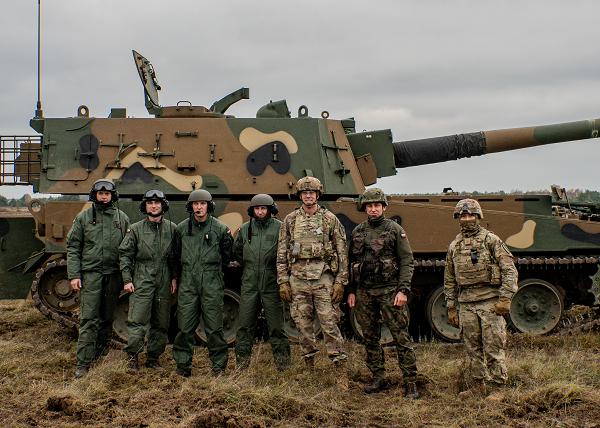
Torun, Poland. (December 25, 2024): Like thousands of deployed U.S. servicemembers, the Soldiers with the 82nd Field Artillery Regiment will celebrate New Years with their host nation. In this photo by Sergeant Jacob Nunnenkamp, Lieutenant Colonel Douglas Mcdonough, 1st Battalion, 82nd Field Artillery Regiment commander, and his counterpart with the Polish Land Forces Major Alistair Fider pose for a family photo with Polish K9 artillerymen during the holidays.
The first thing American troops realize is that everyone does not celebrate the New Year like we do. In Poland, New Years Eve is called "Sylwester" and is celebrated with large, festive gatherings including dancing, fireworks, live music, and lots of food. In fact, food seems to be at the heart of most New Years welcoming’s and almost all are related to hopes for good luck.
In Poland, that food is the pickled herring which is believed to attract wealth. The fish’s shiny scales are thought to resemble coins hence the promise of financial success. Superstition holds that eating pickled herring at midnight is believed to bring a family good fortune in the coming year. Poles also consume opłatek, a kind of wafer, and make special meals that are supposed to bring good luck. During New Year’s Eve or Christmas Eve, people break this wafer with each other while offering good wishes.
- Details
- Hits: 2722
![]()
Bemowo Piskie Training Area, Poland. (December 15, 2024): There is a new hero on the battlefields of Ukraine, the U.S. Army M2A3 Bradley Fighting Vehicle. In this photo by Specialist Trevor Wilson, members of Charlie “Wildcards” Company, 2nd Battalion, 12th Regiment, 1st Armored Brigade Combat Team, 1st Cavalry Division drill with the Bradley and our Polish allies. The Bradley has gained iconic status among Ukrainian troops for its firepower, maneuverability, and safety.
Many Ukrainian soldiers have credited the Bradley with saving their lives.
Ukrainian troops have singled out the Bradley’s M242 Bushmaster 25 mm chain gun for its ability to conquer Russian armor. The chain gun fires up to three hundred rounds per minute and is accurate up to two miles. It is backed up by a 7.62 mm medium machine gun to the right of the chain gun for close up targets. The Bradley is also armed with a TOW missile launcher that carries two loaded missiles capable of destroying most tanks at over two miles.
- Details
- Hits: 2375
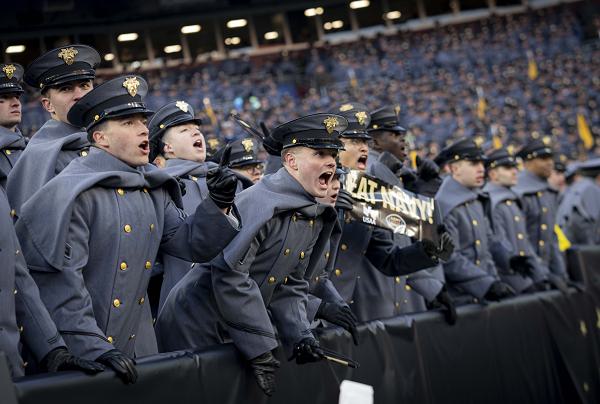
Landover, Maryland. (December 15, 2024): According to sports commentators, the military academies will soon be the “Unicorns” of college football as the last bastion of amateur athletics. In this photo by Benjamin Applebaum, West Point cadets cheer on their team despite suffering a tremendous upset at the hands of their archrival, Navy.
The service academies are called Unicorns for having escaped the recent controversy regarding paying college athletes to play football. In a landmark 2021 Supreme Court ruling, students were granted control over the use of their "name, image, and likeness" or NIL. The ruling held that students enjoy a legal right to control how their image is used, including for commercial purposes, and that they are entitled to seek compensation. The ruling has forever changed college sports by allowing student-athletes to profit from their fame. This is not so for military academy students, for many important reasons.
Unlike their civilian colleagues, academy students are considered federal employees and active-duty members of their respective service. For this reason, athletes are paid a salary, generally in the high fifties, and not allowed to have outside employment. They enjoy free tuition, room, board, medical, and dental coverage. In exchange, students agree to serve five years on active duty and three in the reserves.
- Details
- Hits: 3594
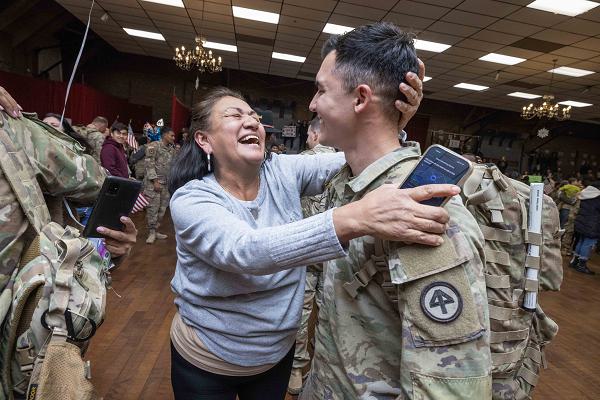
Lawrenceville, New Jersey. (December 3, 2024): In this heart-warming photo by Mark Olsen, family members welcome home 200 U.S. Army Soldiers with the 44th Infantry Brigade Combat Team, New Jersey Army National Guard, just in time for Christmas. The unit deployed to Iraq, Kuwait, and Syria as part of Operation Inherent Resolve. These are the fortunate ones whose situation allows for annual leave and the chance to return home for the holidays.
According to the Bureau of Labor Statistics, civilian employers give their employees just eleven 11 days of paid vacation per year compared to the military standard thirty days a year.
Unlike civilian employers, who offer an average of less than two weeks annual leave, the military grants each employee up to 30 days a year. Also, there is no separate "sick day" category as service members accrue "annual leave" which can be used for any reason including illness. If a servicemember has accrued enough annual leave, they can request annual leave during the holidays with the permission of their unit.
- Details
- Hits: 1119
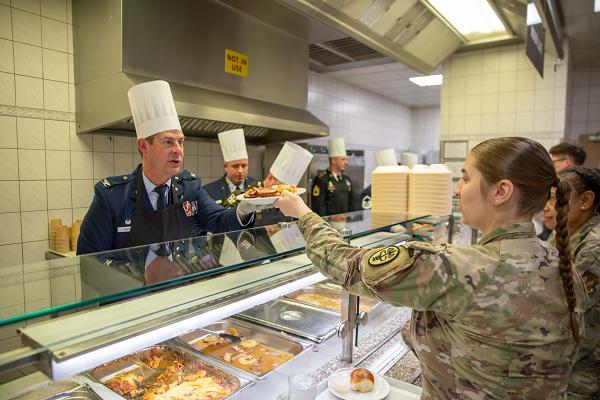
Landstuhl Regional Medical Center, Germany. (December 20, 2024): Although it is impossible to recreate Christmas dinner at home, the American military does its level best. In this photo by the DOD’s Travis Jones, senior leaders and commanders serve holiday meals to service members, employees, and staff. This tradition of officers serving enlisted is an acknowledgement of the vital role enlisted troops play in their unit’s success.
It is also a chance for senior commanders to thank individual servicemembers and staff in a cheerful, holiday atmosphere. The Christmas meal is the center of attention for the 165,000 troops stationed around the world and the 48,900 Sailors underway on ships. According to the Defense Manpower Data Center, there are three carrier strike groups and one amphibious ready group on active watch during the holidays.
This is why the Defense Logistics Agency (DLA), responsible for shipping the key ingredients, goes all out for Christmas. Plans this year call for transporting 690,000 pounds of Christmas fare to America’s deployed servicemembers. This haul includes 6,210 whole turkeys, 176,791 pounds of beef, 98,091 pounds of ham; and 49,055 pounds of shrimp. This is an increase of 26 percent over last year due to increased deployments.


